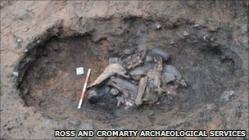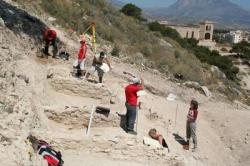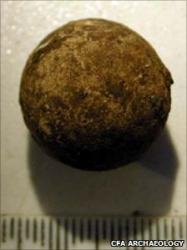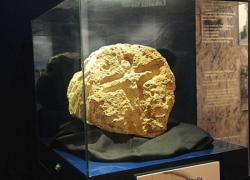04 - 05 JUIN
- ROYAUME-UNI –  Rosemarkie - A horse burial site uncovered by chance during a survey of land for a proposed new house has intrigued archaeologists. The animal's skull and a selection of other bones were excavated at the plot in Rosemarkie, in Ross-shire. Ross and Cromarty Archaeological Services has dated the remains to about 1750 because of a glass bottle from that time also found at the site. Analysis of the bones suggested the small horse was not butchered for dog food nor its bones used to make glue. It is the first horse burial site to be listed on Highland Council's Historic Environment Record database. Mary Peteranna, an archaeologist involved in the survey, described the find as "intriguing" but added it would never be known why only a selection of the horse's skeleton was buried. In April this year, trenches were dug on the plot in Marine Terrace by archaeologists because of its position close to the site of an early monastery. Archaeological remains have also been found in the wider area. Ms Peteranna said the horse bones were found by chance as there was no evidence, or record of, a burial on the plot.
Rosemarkie - A horse burial site uncovered by chance during a survey of land for a proposed new house has intrigued archaeologists. The animal's skull and a selection of other bones were excavated at the plot in Rosemarkie, in Ross-shire. Ross and Cromarty Archaeological Services has dated the remains to about 1750 because of a glass bottle from that time also found at the site. Analysis of the bones suggested the small horse was not butchered for dog food nor its bones used to make glue. It is the first horse burial site to be listed on Highland Council's Historic Environment Record database. Mary Peteranna, an archaeologist involved in the survey, described the find as "intriguing" but added it would never be known why only a selection of the horse's skeleton was buried. In April this year, trenches were dug on the plot in Marine Terrace by archaeologists because of its position close to the site of an early monastery. Archaeological remains have also been found in the wider area. Ms Peteranna said the horse bones were found by chance as there was no evidence, or record of, a burial on the plot.
http://www.bbc.co.uk/news/uk-scotland-highlands-islands-13630945
- ESPAGNE –  La Malladeta - Evidence of an ancient Iberian sanctuary dedicated to the Mother Goddess has been uncovered at a site in Villajoyosa. EFE reports that the project is sponsored by the French Foreign Ministry in collaboration with the local Town Hall. Archaeological experts from the Town Hall and the universities of Alicante and Paris have been working at the dig at La Malladeta since 2005 and their findings are due to be presented in Madrid this summer. They have found clues hidden in the 190 archaeological strata they have investigated which suggest that the site was active as an Iberian sanctuary over the 4th-1st Centuries BC. Items recovered include terracotta fragments of representations of the Mother Goddess, ceramics and pieces of glass, cooking utensils and oil lamps. The experts believe the sanctuary was completely destroyed to make way for a complex of rooms which would have covered the top part of the hill where it stood. They say it was probably still used as a place of worship until 74 AD when Allón, which is now Villajoyosa, received its title as a city.
La Malladeta - Evidence of an ancient Iberian sanctuary dedicated to the Mother Goddess has been uncovered at a site in Villajoyosa. EFE reports that the project is sponsored by the French Foreign Ministry in collaboration with the local Town Hall. Archaeological experts from the Town Hall and the universities of Alicante and Paris have been working at the dig at La Malladeta since 2005 and their findings are due to be presented in Madrid this summer. They have found clues hidden in the 190 archaeological strata they have investigated which suggest that the site was active as an Iberian sanctuary over the 4th-1st Centuries BC. Items recovered include terracotta fragments of representations of the Mother Goddess, ceramics and pieces of glass, cooking utensils and oil lamps. The experts believe the sanctuary was completely destroyed to make way for a complex of rooms which would have covered the top part of the hill where it stood. They say it was probably still used as a place of worship until 74 AD when Allón, which is now Villajoyosa, received its title as a city.
http://www.typicallyspanish.com/news/publish/article_30747.shtml
- USA –  Raven Bluff - This summer, archaeologists are continuing work at a 12,000-year-old prehistoric site which is yielding evidence of generations of wandering hunters who camped on a bluff overlooking the Kivalina River. What they have found is contributing new insights—and contrary new evidence--into the thinking on how humans spread throughout North America at the close of the Pleistocene. The Raven Bluff site was discovered in 2007 by BLM archaeologist Bill Hedman and a crew conducting an archaeological site survey in the far northwest corner of Alaska. The Bering Land Bridge between Russia and North America may have still existed--or had just submerged for the last time--when hunters first frequented Raven Bluff. Essentially the remains of a garbage dump, the dig has offered up the oldest preserved animal bone site in the American Arctic. Rapid soil accumulation, low soil acidity, and perennially frozen conditions at Raven Bluff resulted in bone preservation that is not seen at any other Arctic site of this age. The people that came here would be astounded by the time, energy and thought we’re spending exploring garbage they wouldn’t have given a thought to. But it’s telling us what people were eating, what seasons they were at the site, how they were processing animals, how they carried, preserved and stored food. For example, the notion that people at this time period were bison hunters in Northern Alaska is being put to the test; twelve thousand years ago, what is now moist tundra was a drier, grassier, landscape grazed by animals that included bison, but caribou bones are what scientists are finding at Raven Bluff so far. Another established scientific hypothesis being tested is how the use of certain stone tools spread in North America. The lower levels of the site produced a very significant find of a roughly 12,000 year-old fluted projectile point base, marking the first time such a tool has been definitely dated in the north. The idea for decades has been that fluted projectile point technology originated in Alaska or perhaps Siberia and was carried south into the Americas. This model suggests that the Raven Bluff tool should be older than similar points found further south on the continent. “We’re finding the opposite of what people expected. "The Raven Bluff points are younger than Clovis, so it may be that they did not originate in the north, but came from the south. So the question now is, does this represent a migration of people, or the spread of an idea from the south?”
Raven Bluff - This summer, archaeologists are continuing work at a 12,000-year-old prehistoric site which is yielding evidence of generations of wandering hunters who camped on a bluff overlooking the Kivalina River. What they have found is contributing new insights—and contrary new evidence--into the thinking on how humans spread throughout North America at the close of the Pleistocene. The Raven Bluff site was discovered in 2007 by BLM archaeologist Bill Hedman and a crew conducting an archaeological site survey in the far northwest corner of Alaska. The Bering Land Bridge between Russia and North America may have still existed--or had just submerged for the last time--when hunters first frequented Raven Bluff. Essentially the remains of a garbage dump, the dig has offered up the oldest preserved animal bone site in the American Arctic. Rapid soil accumulation, low soil acidity, and perennially frozen conditions at Raven Bluff resulted in bone preservation that is not seen at any other Arctic site of this age. The people that came here would be astounded by the time, energy and thought we’re spending exploring garbage they wouldn’t have given a thought to. But it’s telling us what people were eating, what seasons they were at the site, how they were processing animals, how they carried, preserved and stored food. For example, the notion that people at this time period were bison hunters in Northern Alaska is being put to the test; twelve thousand years ago, what is now moist tundra was a drier, grassier, landscape grazed by animals that included bison, but caribou bones are what scientists are finding at Raven Bluff so far. Another established scientific hypothesis being tested is how the use of certain stone tools spread in North America. The lower levels of the site produced a very significant find of a roughly 12,000 year-old fluted projectile point base, marking the first time such a tool has been definitely dated in the north. The idea for decades has been that fluted projectile point technology originated in Alaska or perhaps Siberia and was carried south into the Americas. This model suggests that the Raven Bluff tool should be older than similar points found further south on the continent. “We’re finding the opposite of what people expected. "The Raven Bluff points are younger than Clovis, so it may be that they did not originate in the north, but came from the south. So the question now is, does this represent a migration of people, or the spread of an idea from the south?”
Video = http://www.youtube.com/watch?v=PXxYBHwZstY
http://community.adn.com/node/157217#ixzz1OKjwUKHP
- ROYAUME-UNI –  Lochaber - A musket ball has been found in a part of the Highlands with close links to Bonnie Prince Charlie which was later used for training secret agents. Archaeologists said the find at Lochailort in Lochaber was post medieval and it would be sent to the Royal Armouries in Leeds for analysis. Prince Charles Edward Stewart fled Scotland from nearby Loch nan Uamh. Spent bullets thought to date from Lochailort's use as a camp during World War II have also been uncovered. The lead musket ball and 84 spent bullets were among 296 metallic objects detected by the archaeologists. At the moment it is not known from what period the lead ball dates from. Evidence of more peaceful activities in the area were also found, including part of a ploughshare. Lochailort is close to two lochs that played key roles in the rise and fall of 1745 Jacobite rebellion. Bonnie Prince Charlie's standard was raised at Glenfinnan following his landing on mainland Scotland in August 1745. Following his defeat at the Battle of Culloden in April 1746, the prince returned to the area and fled to France from Loch nan Uamh. During World War II, members of Winston Churchill's "secret army", the Special Operations Executive (SOE), were believed to have trained at Lochailort. Nearby Inverailort House was taken over by the military in 1940 for use as an SOE training base.
Lochaber - A musket ball has been found in a part of the Highlands with close links to Bonnie Prince Charlie which was later used for training secret agents. Archaeologists said the find at Lochailort in Lochaber was post medieval and it would be sent to the Royal Armouries in Leeds for analysis. Prince Charles Edward Stewart fled Scotland from nearby Loch nan Uamh. Spent bullets thought to date from Lochailort's use as a camp during World War II have also been uncovered. The lead musket ball and 84 spent bullets were among 296 metallic objects detected by the archaeologists. At the moment it is not known from what period the lead ball dates from. Evidence of more peaceful activities in the area were also found, including part of a ploughshare. Lochailort is close to two lochs that played key roles in the rise and fall of 1745 Jacobite rebellion. Bonnie Prince Charlie's standard was raised at Glenfinnan following his landing on mainland Scotland in August 1745. Following his defeat at the Battle of Culloden in April 1746, the prince returned to the area and fled to France from Loch nan Uamh. During World War II, members of Winston Churchill's "secret army", the Special Operations Executive (SOE), were believed to have trained at Lochailort. Nearby Inverailort House was taken over by the military in 1940 for use as an SOE training base.
http://www.bbc.co.uk/news/uk-scotland-highlands-islands-13640168
- CHINE – Xi’an - Northwest China's Shaanxi province initiated the comprehensive archaeological and excavation work at the K9901 attendant burial pit - one of 180 funerary pits of the Qin Shihuang (259-210 BC) tomb - and its surrounding construction sites on Friday, according to the site's archaeological team. The burial pit is located in the southeast area of the Tomb of Qin Shihuang (the "First Emperor" of a united China), and occupies a 700-square-meter area of the burial area. The tomb site, situated in the suburban area of Xi'an city, is divided into two parts: an 8-square-kilometer cemetery site and 56.25-square-kilometer multi-burial areas. In 1999, the Shaanxi archaeological team opened up one 4-meter-wide and 17-meter-long exploratory trench in the middle of K9901 from south to north, and carried out a partial excavation. From the test excavation, one 70-cm-wide and 61-cm-high tripod vessel and 11 pottery figurines were uncovered in the burial area. The tripod vessel weighed 212 kg, with an elegant shape, grand imposing manner, and smooth ridges. The pottery figurines stood bare on their upper bodies, which was the first time warriors have been found without armor or war shirts. Twelve years later, the new digging will provide "a comprehensive and in-depth understanding of the structure, characters and contents of the K9901 funerary pit. With relatively small scale and simple form, the K9901 funerary pit is one of more than 180 burial areas of Qin Shihuang. Since 1974, more than 30 funerary pits have been excavated by Chinese archaeological teams.
http://news.xinhuanet.com/english2010/culture/2011-06/04/c_13910700.htm
- MALTE –  Ras il-Wardija - At the the Gozo Museum of Archaeology the lost Graphite from Ras il-Wardija is on display. The graphite was originally located beside one of the decorative niches of the temple. It was reported stolen in March 1988, but was located and returned to the collection some twenty years later. Ras il-Wardija is an important historical site and is situated at the limits of Santa Lucija, on the extreme South West point of Gozo. In this area one can find various Punico-Hellenistic remains including a sanctuary. The sanctuary is divided into two distinct areas: The upper part, consisting of a rock cut chamber and a cistern, and a lower terrace where the remains have been less well preserved, although a few blocks of stone can still be traced. During Phoenician times this area flourished as a place of cult dedicated to an as yet unknown deity. It was also utilized for a similar purpose during the Roman period, after which the sanctuary fell in decay until it was used as a troglodyte dwelling in the medieval period.
Ras il-Wardija - At the the Gozo Museum of Archaeology the lost Graphite from Ras il-Wardija is on display. The graphite was originally located beside one of the decorative niches of the temple. It was reported stolen in March 1988, but was located and returned to the collection some twenty years later. Ras il-Wardija is an important historical site and is situated at the limits of Santa Lucija, on the extreme South West point of Gozo. In this area one can find various Punico-Hellenistic remains including a sanctuary. The sanctuary is divided into two distinct areas: The upper part, consisting of a rock cut chamber and a cistern, and a lower terrace where the remains have been less well preserved, although a few blocks of stone can still be traced. During Phoenician times this area flourished as a place of cult dedicated to an as yet unknown deity. It was also utilized for a similar purpose during the Roman period, after which the sanctuary fell in decay until it was used as a troglodyte dwelling in the medieval period.
http://gozonews.com/17954/lejlet-lapsi-notte-gozitana-2011-activities-underway/
 INSCRIPTIONS ANNEE 2011 - 2012
INSCRIPTIONS ANNEE 2011 - 2012
VOIR MENU : COURS ONLINE